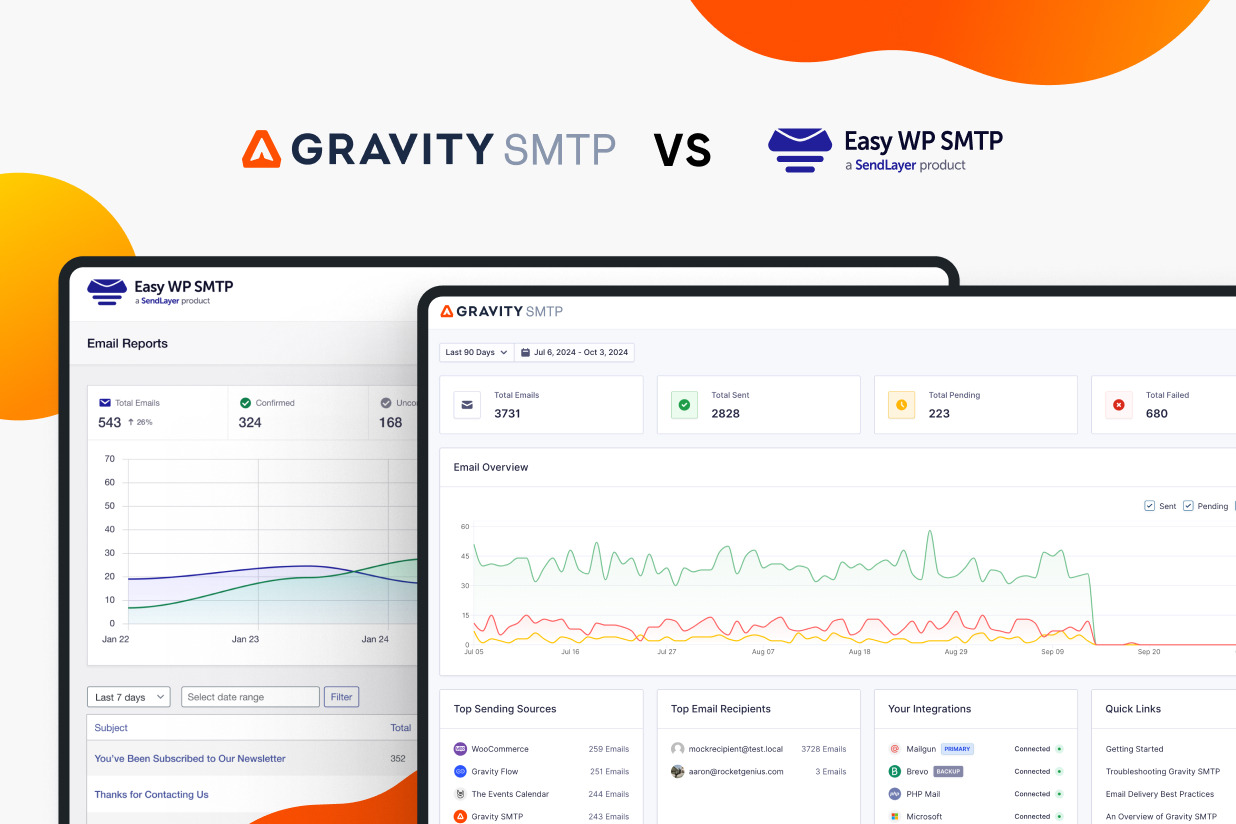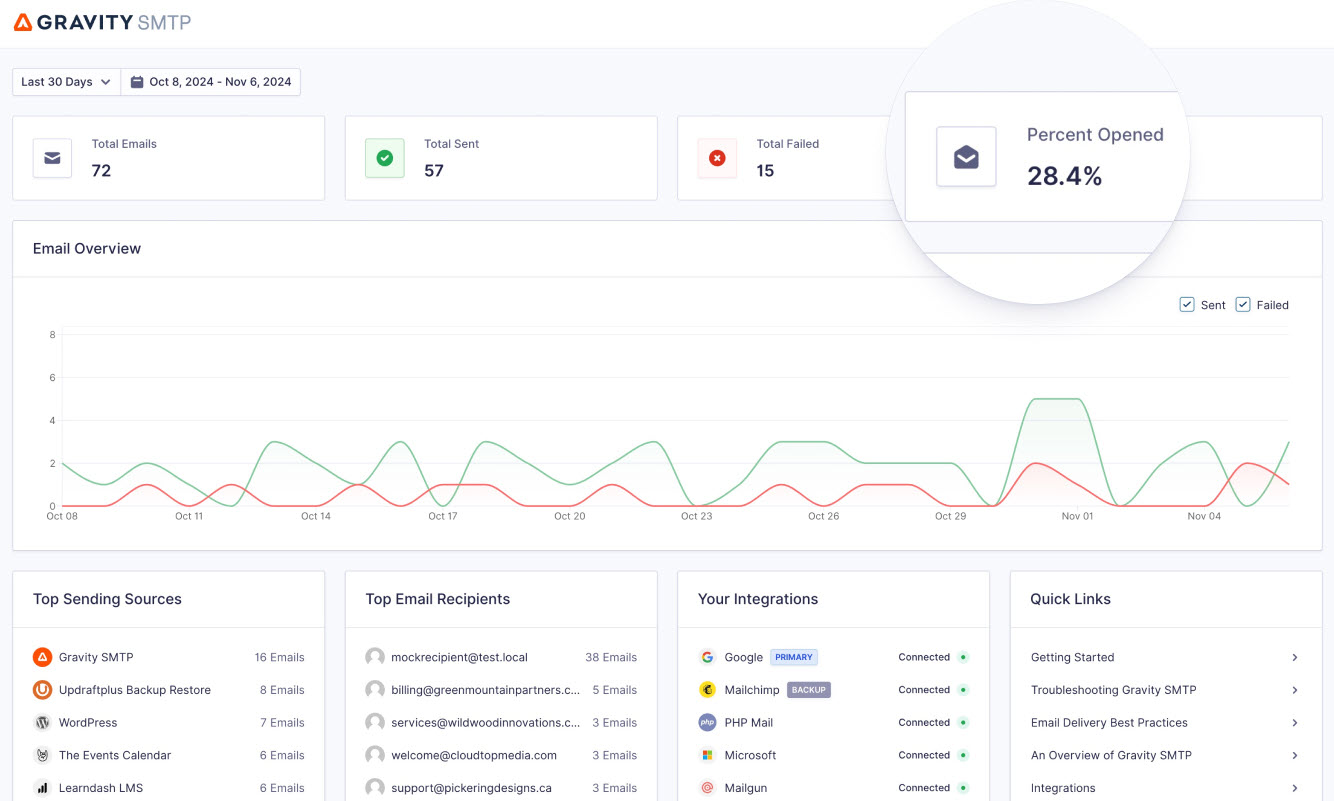Easy WP SMTP vs Gravity SMTP: A Complete Comparison
Trying to choose between Gravity SMTP vs Easy WP SMTP as your WordPress SMTP plugin?
Gravity SMTP and Easy WP SMTP both give you tools to send your WordPress site’s emails using a transactional email sending service. But while they share some similarities, there are also some important differences that might make one plugin better for your specific situation.
In this post, we’ll compare these two SMTP plugins so that you can pick the right option for your specific situation.
We’re not going to pick a single “winner”. Rather, we’re just going to try to highlight the similarities and differences so that you can make the right choice.
Let’s get into it…
Quick Introductions
Before we get to the hands-on comparisons, let’s quickly run over some basic introductions to these two plugins.
Easy WP SMTP Introduction
Easy WP SMTP is an SMTP plugin owned by SendLayer, an email sending service. However, Easy WP SMTP integrates with lots of other transactional email services beyond SendLayer, so you aren’t required to use SendLayer to use the plugin.
In turn, SendLayer is owned by Awesome Motive. This means that the Easy WP SMTP plugin actually comes from the same parent company as the WP Mail SMTP plugin, and you’ll notice a lot of similarities between the two when it comes to their features and pricing (though there are also some differences between Easy WP SMTP vs Easy WP SMTP).
Gravity SMTP Introduction
Gravity SMTP is a WordPress SMTP plugin from the same team behind the popular Gravity Forms plugin, which is a full-service WordPress form plugin.
Despite that connection, Gravity SMTP is a completely standalone plugin that works for all of your WordPress site’s emails, including core emails and emails from any other plugins that use wp_mail (such as Gravity Forms).
You can install Gravity SMTP by itself or alongside Gravity Forms – it will help you out either way.
Email Sending Service Integrations
Now, let’s look at the direct email sending service integrations that both plugins support.
First, it’s important to note that both plugins give you the option of connecting to a custom SMTP server. That is, you are by no means limited to just the direct API integrations on this list. You can use literally any sending service that provides you with SMTP credentials.
However, we do still recommend using a direct API integration whenever possible. At some transactional email service, using the API integration will be a little faster and more reliable than the SMTP integration. For example, emails might send in 5 seconds instead of 30 seconds (which is important for time-sensitive emails like password resets).
Using an API also lets you add an extra layer of security, as some email sending services will use your account’s username and password for the SMTP credentials.
Currently, both Gravity SMTP and Easy WP SMTP offer direct integrations for the following services:
Note – for Easy WP SMTP, you’ll need the premium version to access Amazon SES, Gmail, and Outlook. Gravity SMTP only has one version, which supports all of the integrations.
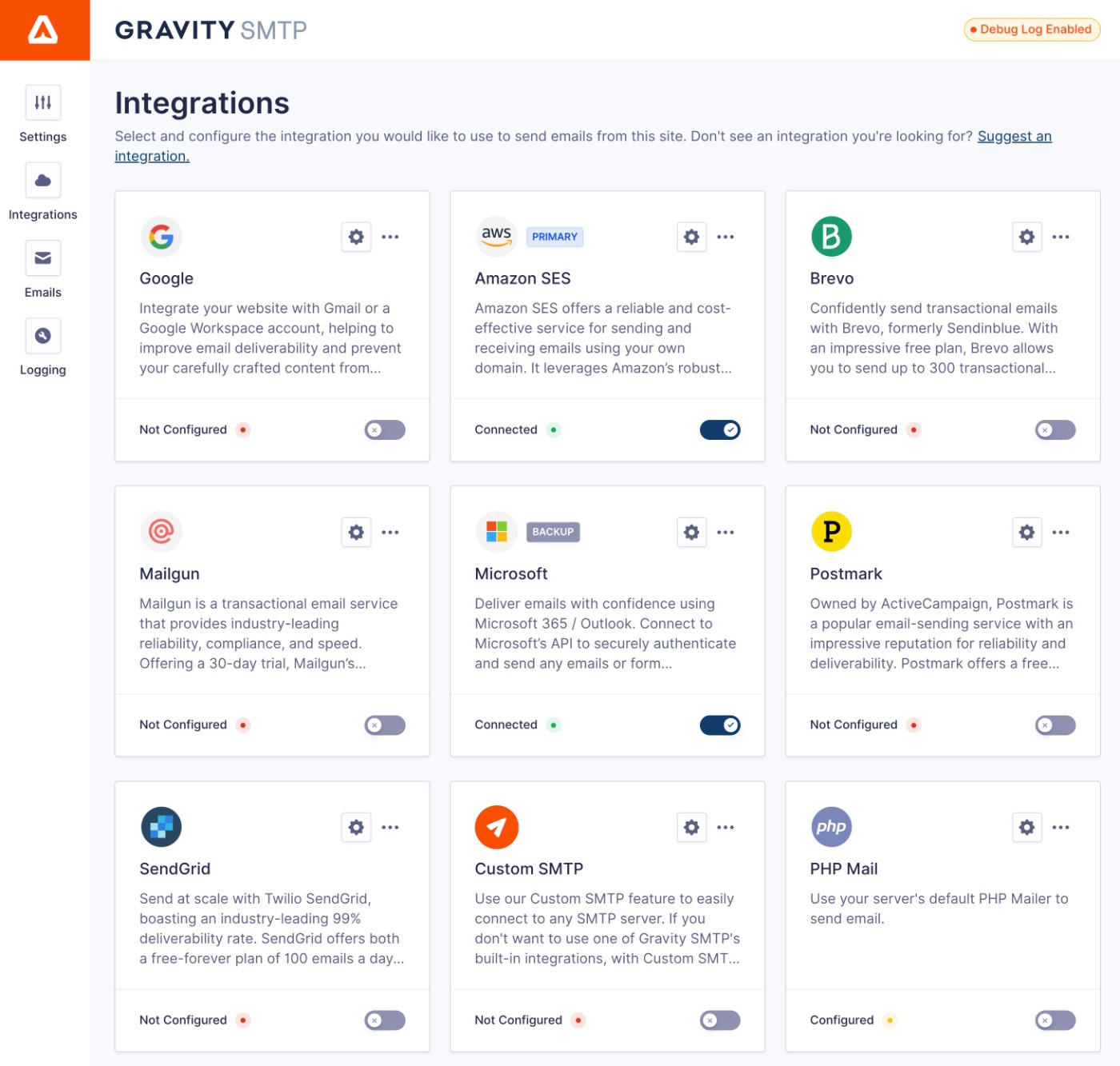
Gravity SMTP additionally supports the Mailchimp Transactional email service (formerly Mandrill).
Currently, Easy WP SMTP also supports a few additional services:
- SendLayer (the company that owns Easy WP SMTP)
- SMTP.com
- SMTP2GO
- SparkPost
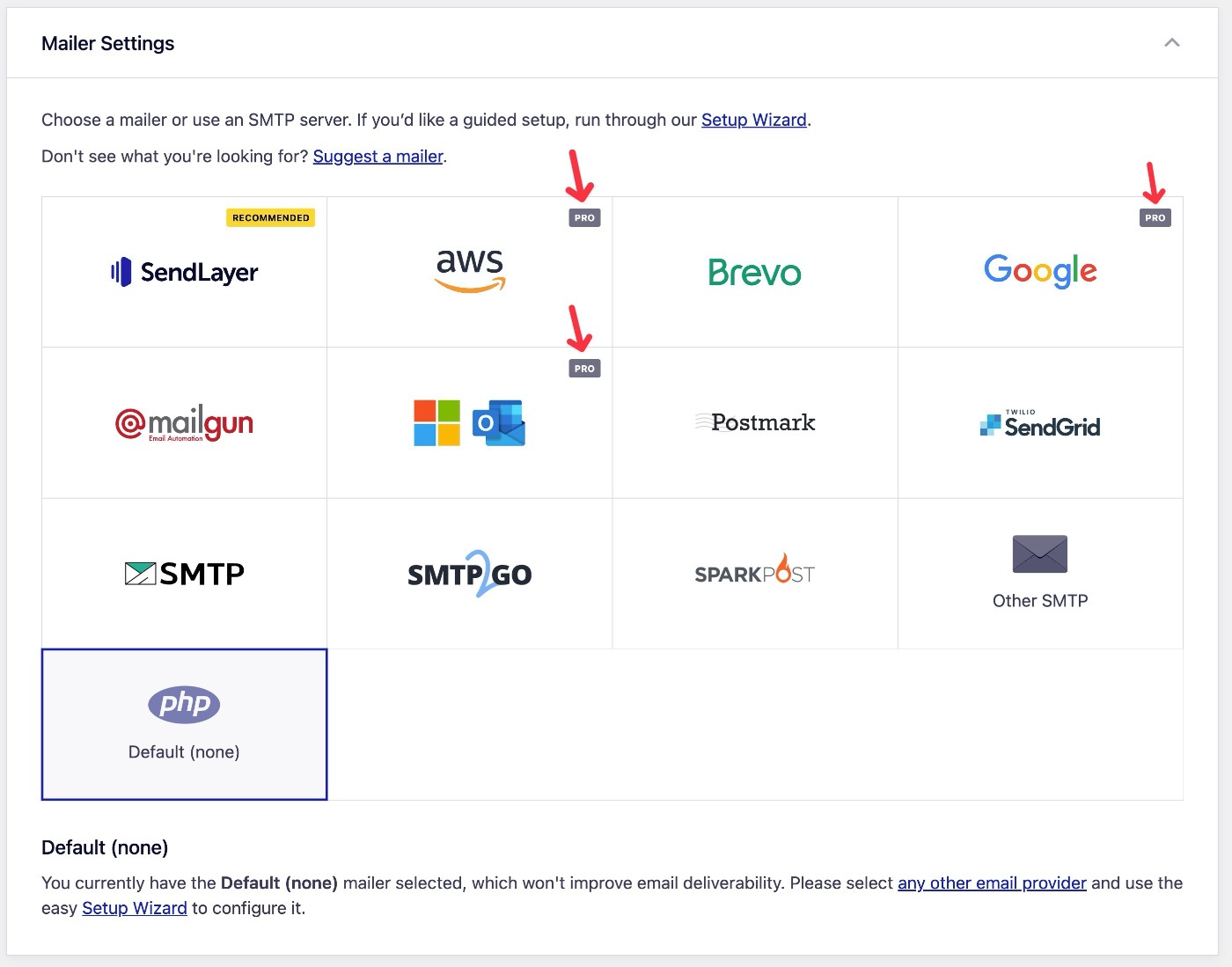
If you want to use one of those four services, that might give Easy WP SMTP an advantage. However, we think that most people will be better off using one of the options from the first list, as those are some of the best transactional email providers.
Gravity SMTP is also working hard on adding even more integrations, which you can view on the Gravity SMTP product roadmap.
If there’s a specific integration that you want to see, you can also submit it for consideration and/or vote on the features/integrations that you want to see added. Some of the integrations that are currently receiving votes on the roadmap include Elastic Email, Zoho Mail, and MailerSend.
Easy WP SMTP vs Gravity SMTP Pricing
When it comes to pricing, there are some notable differences between Easy WP SMTP and Gravity SMTP and each can be the more affordable option in different situations.
Easy WP SMTP Pricing
To start, Easy WP SMTP has a basic free version at WordPress.org that offers core features and a limited selection of integrations.
If you want to access all of the integrations and features in Easy WP SMTP, you’ll need to go with one of the four paid plans.
All of the paid plans give you access to the same features. The only difference is the number of sites on which you can use the plugin.
The plans start at $99 for use on a single site and range up to $599 for use on up to 50 websites (along with priority support). There’s no unlimited site option, so you would need to purchase multiple licenses if you have more than 50 sites.
One thing to note is that Easy WP SMTP will discount the first year by 50%. However, this discount only applies to the first year. If you want to continue using the premium features after the first year, your license will renew at regular price.
For example, the single-site Basic license costs $49.50 for the first year. After that, every subsequent year would cost $99.
Here are all four pricing plans – the crossed-out number at the top is the regular price that you’ll pay after the first year.
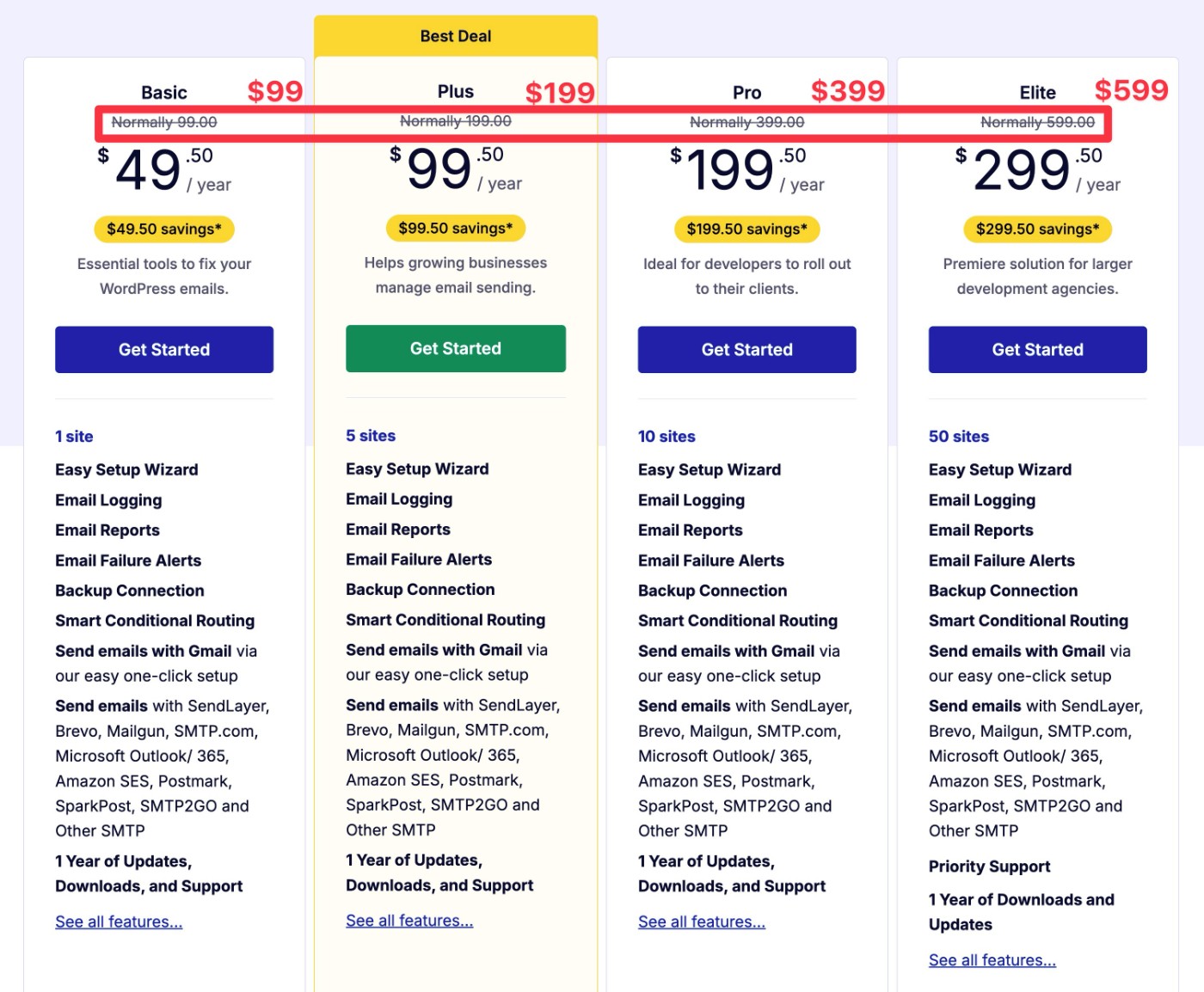
Gravity SMTP Pricing
Gravity SMTP is currently available for free to anyone who’s holding one of these Gravity Forms licenses:
- Elite license – $259 for new purchases, or you can upgrade from a lower license and only pay the prorated difference.
- Nonprofit license – $129 for registered non-profits.
- Developer license – this is a legacy license that’s no longer for sale.
If you’re already holding one of these licenses, you can download Gravity SMTP directly from your Gravity Forms Account area.
There’s only one version of Gravity SMTP, so the free version will give you access to every single feature and integration.
Pricing Comparison Table
To make the pricing differences crystal clear, let’s go through a pricing comparison table of what it would cost you to access all premium features on different numbers of sites (at full price).
For Gravity SMTP, we’ll divide it into two scenarios:
- Someone who’s already holding the Gravity Forms Elite, Nonprofit, or Developer licenses.
- Someone who doesn’t have any Gravity Forms license yet. If you’re already holding the Gravity Forms Basic or Pro licenses, you could upgrade your license to Elite and only pay the prorated difference, which would save you some money. Or, registered nonprofits could use the Nonprofit license to save some money.
| Sites | Gravity SMTP (No Gravity Forms license) |
Gravity SMTP (Existing Gravity Forms Elite, Nonprofit, or Developer license holder) |
Easy WP SMTP |
| 1 site | $259 | Free | $99 |
| 2 sites | $259 | Free | $199 |
| 5 sites | $259 | Free | $199 |
| 10 sites | $259 | Free | $399 |
| 30 sites | $259 | Free | $599 |
| 50 sites | $259 | Free | $599 |
| 100 sites | $259 | Free | $998 (two licenses) |
As you can see, if you’re already holding one of these Gravity Forms licenses, Gravity SMTP is a no-brainer in terms of the costs.
If you’re not holding the Gravity Forms Elite license yet, Easy WP SMTP could be a little bit cheaper if you only need an SMTP plugin for five or fewer sites. After that, Easy WP SMTP will be significantly more expensive.
Plus, remember that your purchase of the Gravity Forms Elite license also gives you access to every single Gravity Forms Add-On, which adds a lot of extra value.
Email Logging and Alert Features
To help you monitor your site’s emails and quickly detect any potential issues, both plugins offer various logging and reporting options.
Easy WP SMTP Email Logging
If you want to access the logging and reporting features in Easy WP SMTP, you’ll need to upgrade to the premium version. The free version at WordPress.org does not support either logging or reports.
If you do have the premium version, you can access email logging from the Email Log tab of the plugin’s settings. You can view technical information about the plugin, along with whether it was opened or clicked. You can also choose to log the email content and attachments.
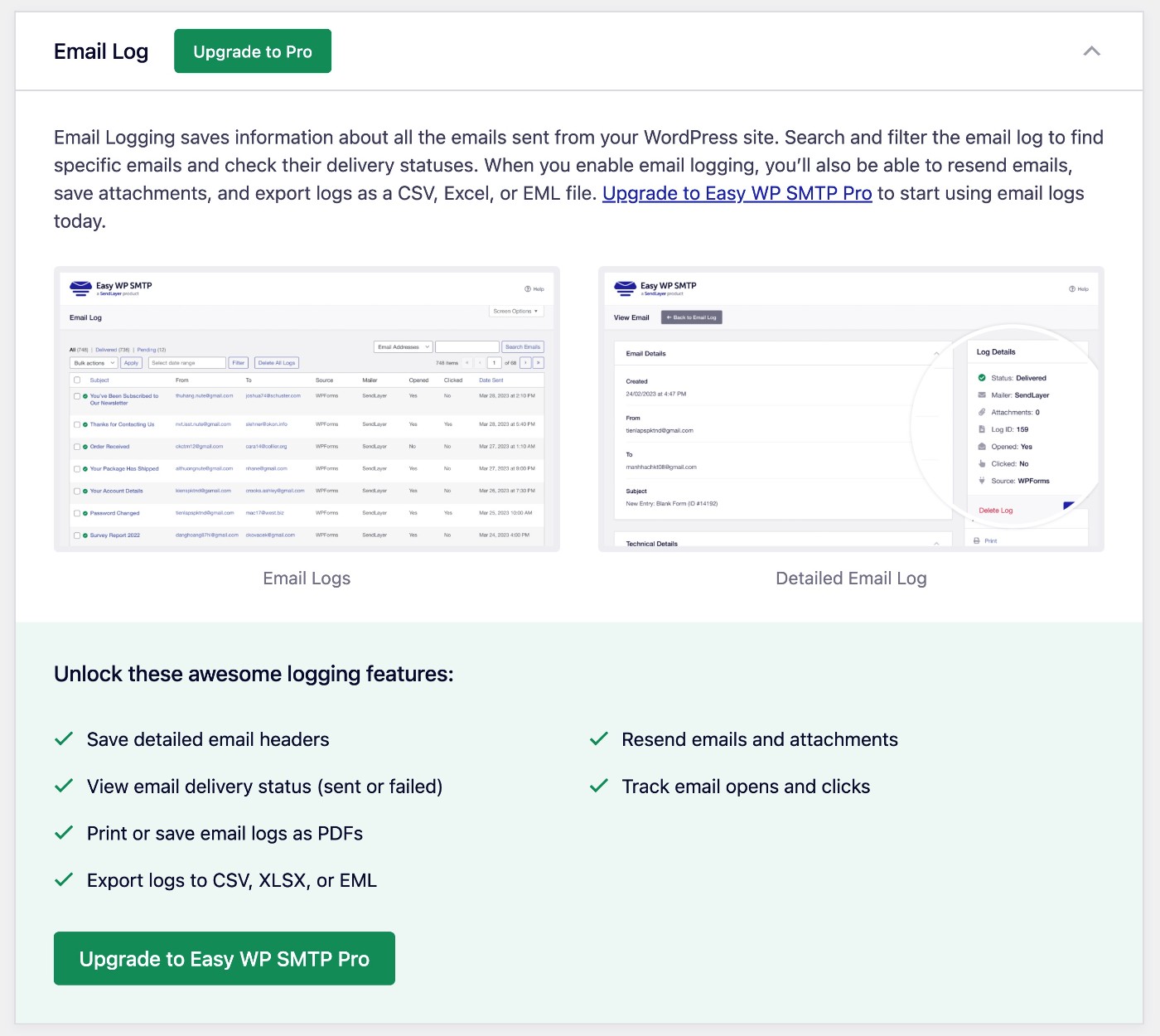
There’s also a separate reporting dashboard that gives you access to more high-level reports, such as the total number of emails that your site sends and click/open rates.
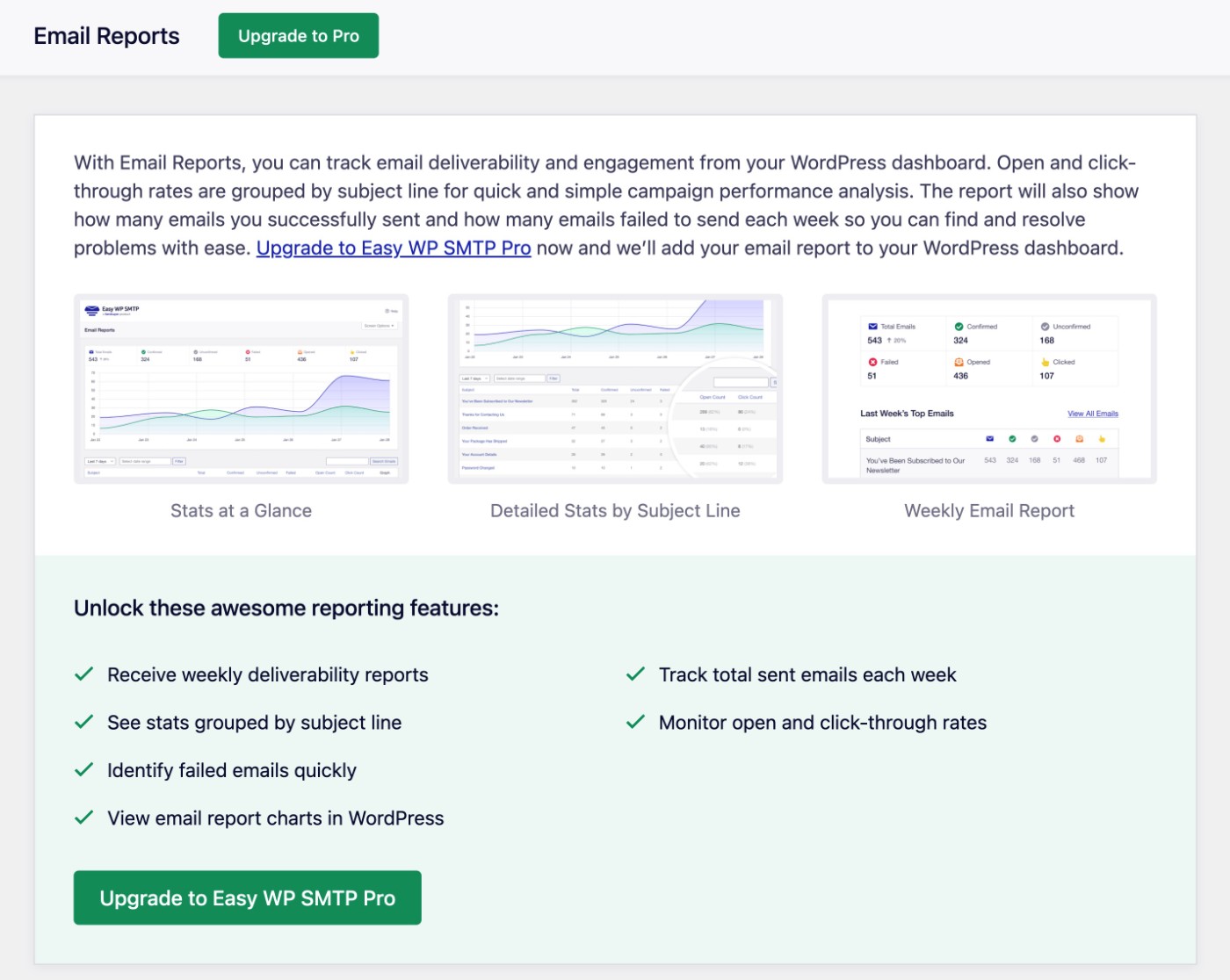
Gravity SMTP Email Logging
Gravity SMTP includes both high-level reporting and detailed email logging.
With the email log, you can see a list of every single email that your site has sent, with options to fully control the log storage period (or disable it altogether if preferred).
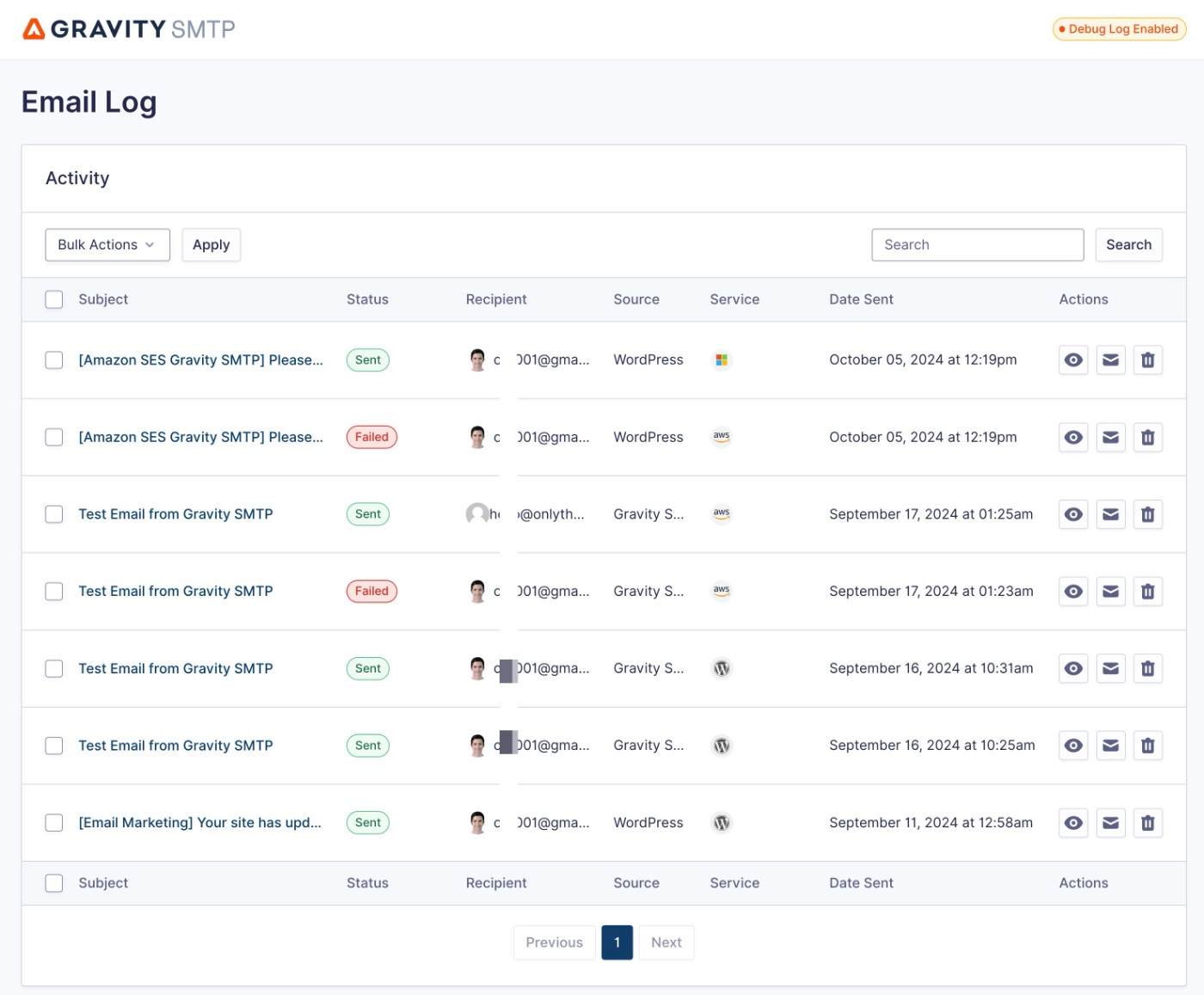
If you select an individual email, you can view more technical information about that email, such as its source (e.g. a certain plugin) and other data. You can also manually resend an email, if needed.
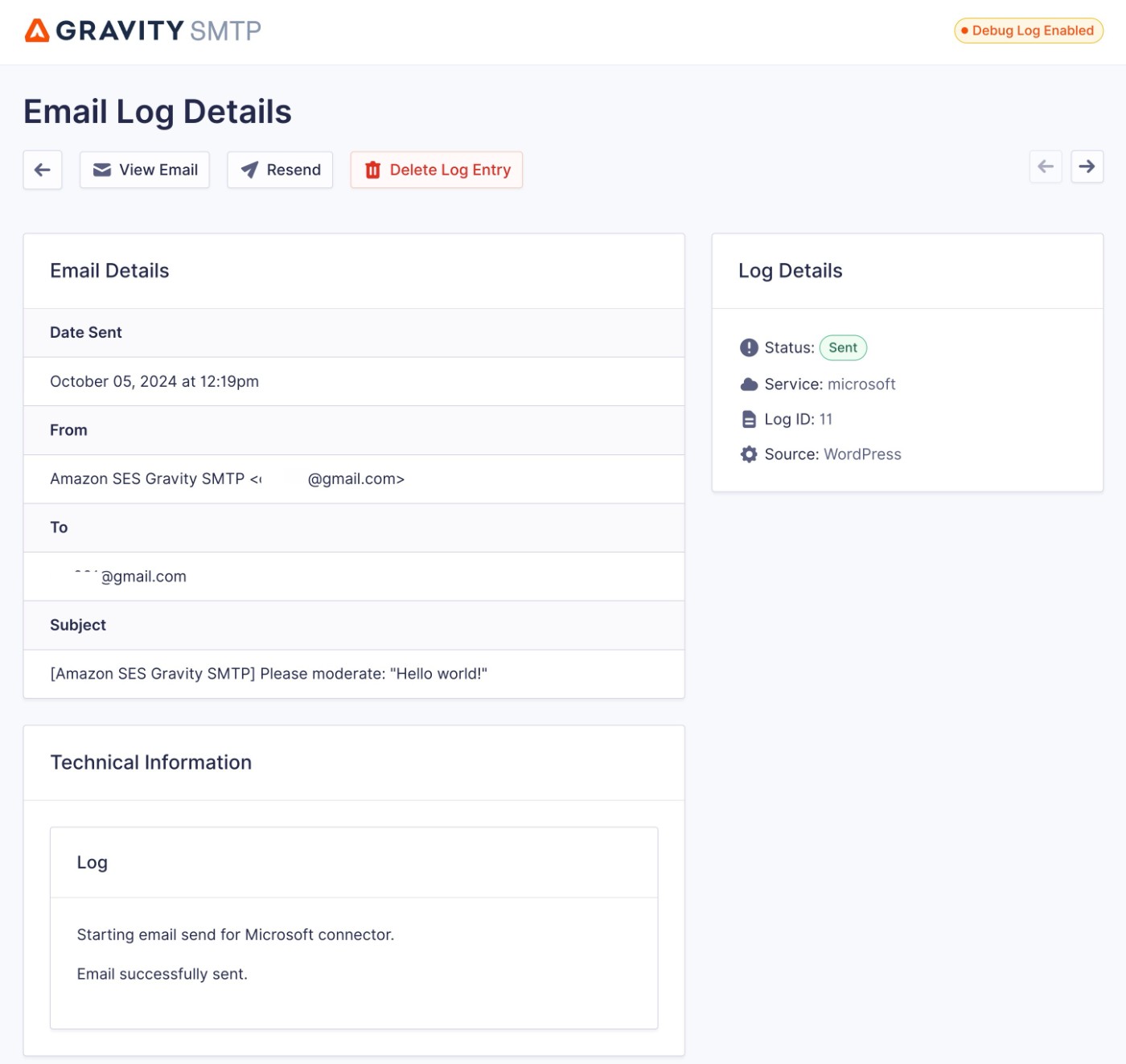
You can also view the content and design of each individual email, including an option to see how the email looks on both desktop and mobile devices. You can also disable the storage of email content, if you’d rather just store the technical information.
You also have the option of whether or not to log email attachments.
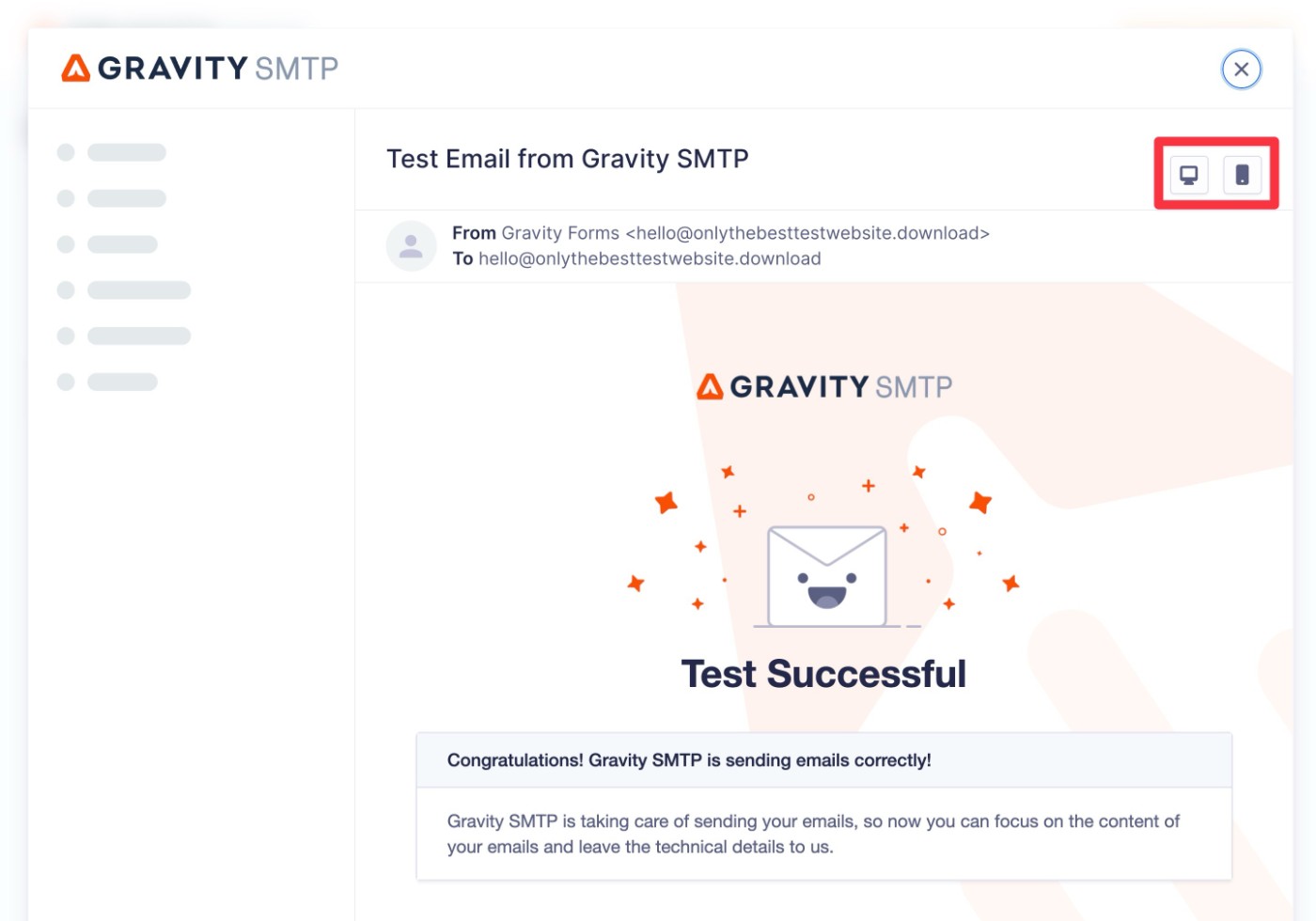
In addition to the email logging feature, Gravity SMTP also offers a reporting dashboard that lets you more easily visualize your site’s email sending and opening data.
For example, you can quickly see your site’s email open rate, which sources are sending the most emails (e.g. core WordPress or a plugin), the most common recipients, and more.
Email Testing Features
To help you test your site’s integrations, both plugins include a feature that lets you send a test email to any email address.
Here’s what that feature looks like in Easy WP SMTP:
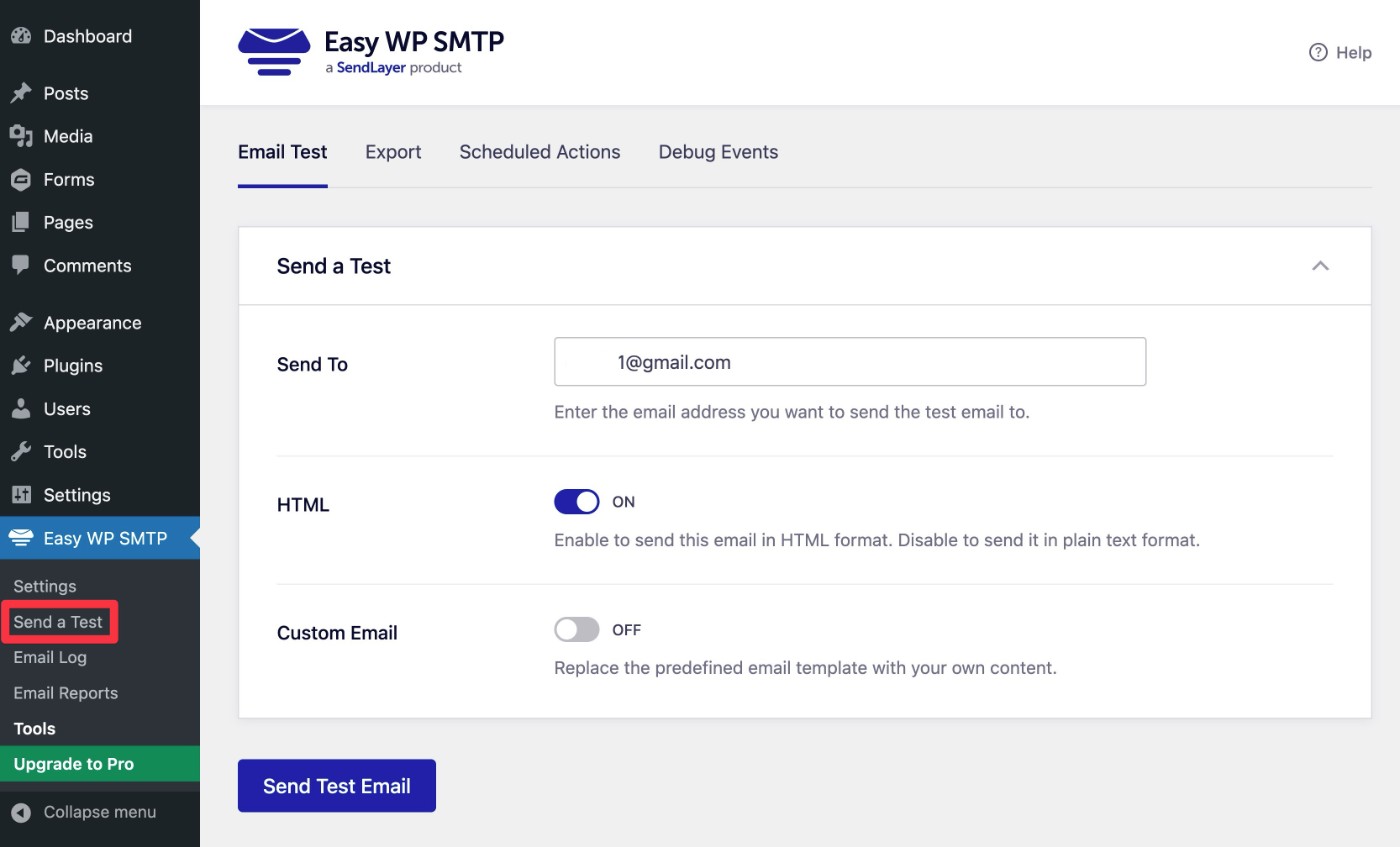
And then here’s how it looks in Gravity SMTP:
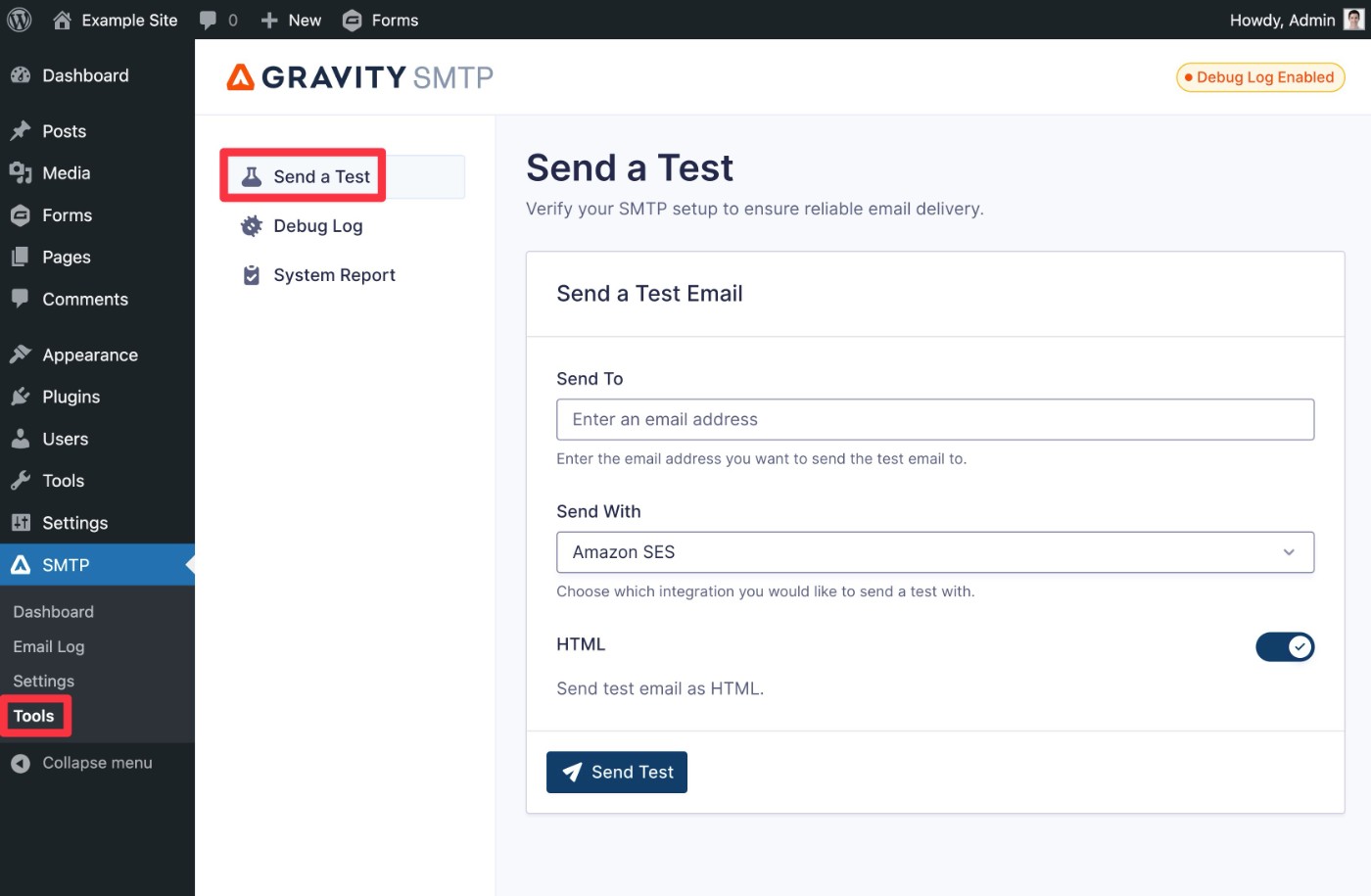
Beyond that, Gravity SMTP also includes a test mode feature, which isn’t something that Easy WP SMTP currently offers. If you put your site into test mode, Gravity SMTP will disable any live email sending but still log all of the emails that your site would have sent in the email log.
For example, you might find this feature helpful if you’re working on a local development site. You can still test and debug your site’s emails, but without needing to connect your local install to a sending service.
Email Routing Features
If you just want to send all of your site’s emails with a single transactional email service, you might not care about routing controls.
However, for more advanced implementations, both plugins let you send emails using different services if certain criteria are met. For example, if an email fails to send with your primary email sending service, both plugins let you specify an automatic backup service.
Easy WP SMTP Email Routing
Easy WP SMTP does not offer any email routing features in the free version at WordPress.org.
However, if you upgrade to the premium version, you have two high-level features to route your emails.
First off, you can connect your site to multiple services and specify one service as a backup connection.
Second, you can also conditionally route emails based on details such as the initiator, subject, from address, and so on.
Gravity SMTP Email Routing
To help you ensure the reliability of your site’s emails, Gravity SMTP makes it easy to set up a backup email sending service.
If an email fails to send via your primary email sending for any reason, Gravity SMTP will automatically resend the email using your backup service. This lets you ensure reliable email deliverability even if there’s a problem with your primary service.
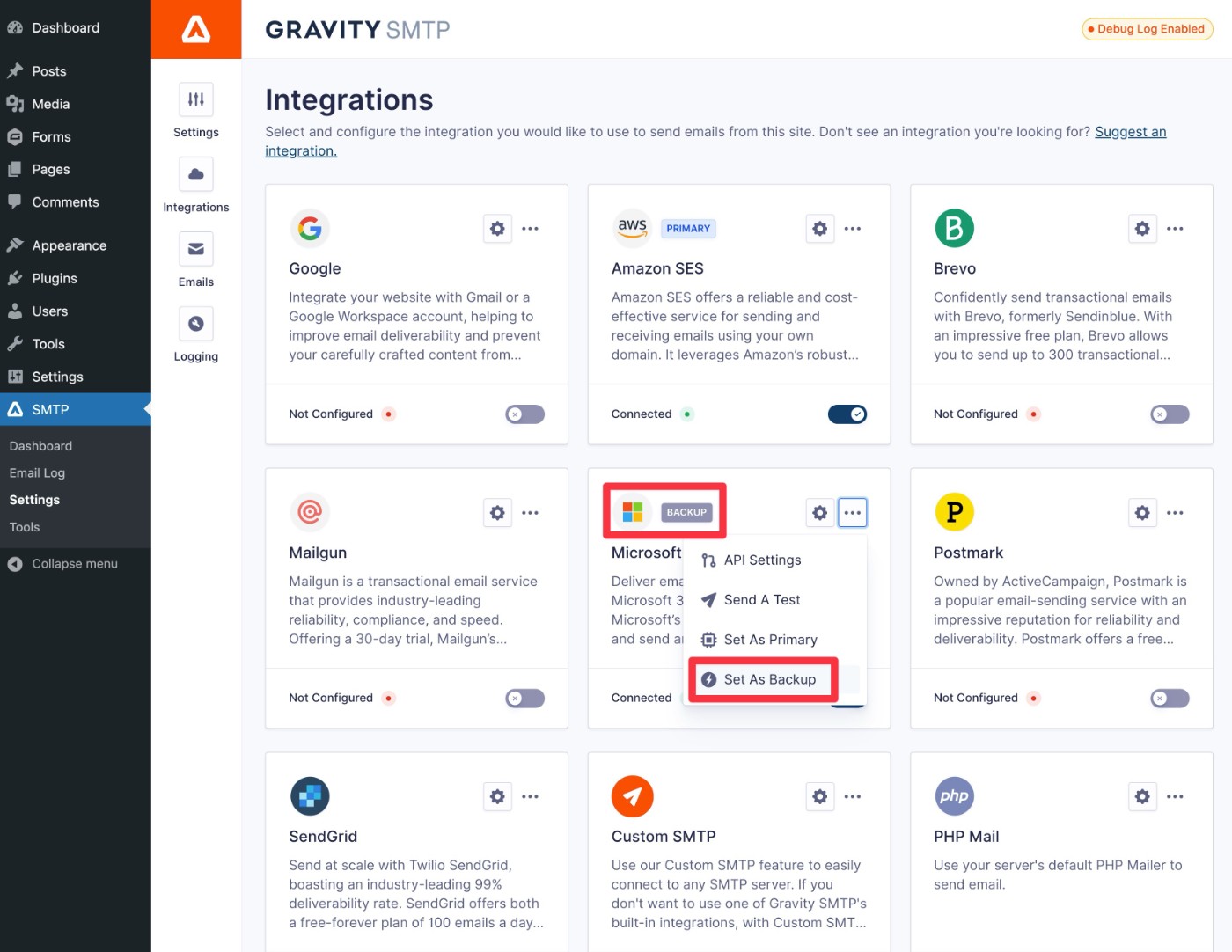
Currently, Gravity SMTP does not offer conditional email routing like Easy WP SMTP. However, this type of smart routing is already under consideration on the Gravity SMTP product roadmap. If conditional routing is important to you, you can vote on this feature to let the Gravity SMTP team know it should be a priority.
Email Management Features
Finally, let’s look at the tools that both plugins give you to control which emails your site sends.
Easy WP SMTP
Easy WP SMTP doesn’t offer any granular control over which individual emails your site sends in the free version..
However, if you upgrade to the premium version, you can access an Email Controls area that lets you enable or disable individual core WordPress emails.
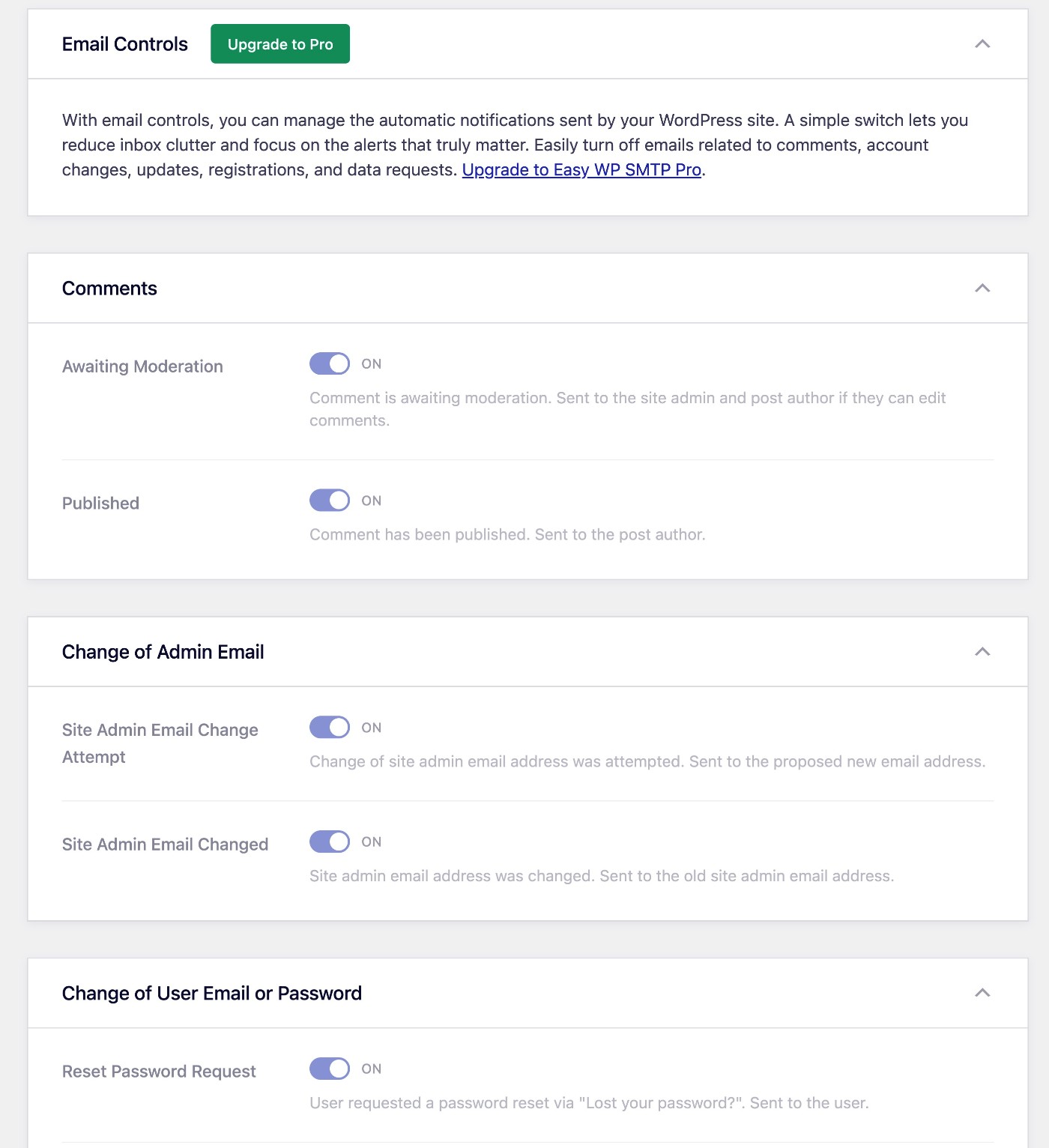
Gravity SMTP
Gravity SMTP gives you an interface where you can enable or disable all of the individual emails that the core WordPress software sends, such as new comment notifications, new user notifications, email change notifications, and more.
You can access it by going to SMTP → Settings → Emails and using the toggles to enable or disable individual emails.
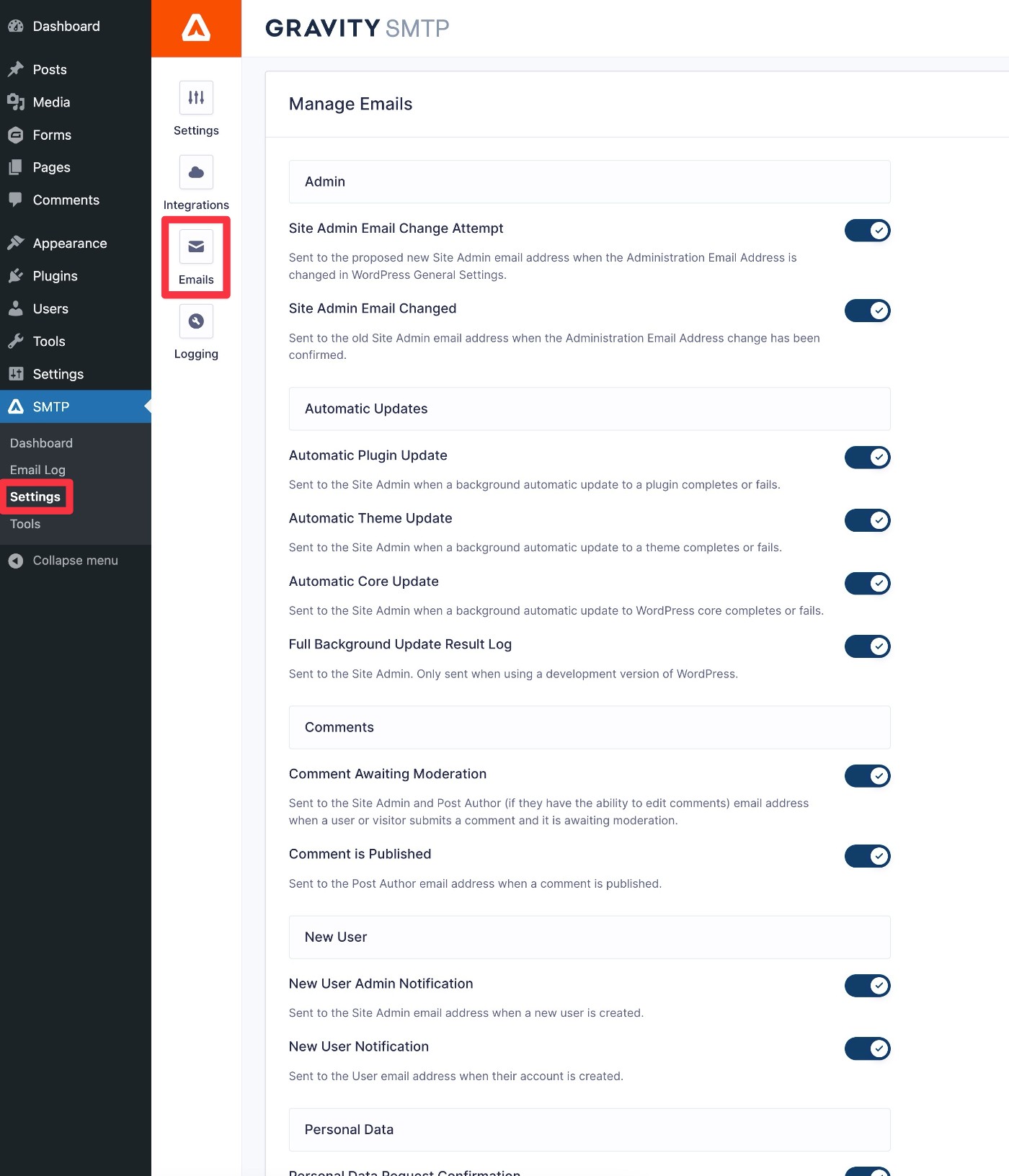
Pick the Right Plugin for Your Needs
In the end, both Gravity SMTP and Easy WP SMTP have their strong points.
If you’re already holding the Gravity Forms Elite, Nonprofit, or Developer licenses (or are interested in using one of those Gravity Forms licenses), Gravity SMTP gives you free functionality that equals a lot of the features in the paid Easy WP SMTP plugin.
At no extra cost, Gravity SMTP lets you access integrations like Amazon SES and Gmail, along with lots of helpful features such as backup sending connections, detailed email logging, reporting, WordPress email management, and more.
If you’re ready to get started, download Gravity SMTP from your My Account area and follow our ultimate guide to Gravity SMTP to set up everything.

If you want to keep up-to-date with what’s happening on the blog sign up for the Gravity Forms newsletter!
